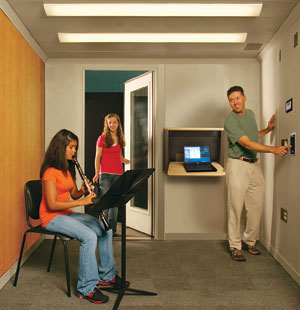First in Their Class: Innovative Design Solutions for Schools of the Future
Practice Makes Perfect
Measuring with Sound Transmission
Class (STC) Ratings As defined in the ANSI Standard S12.60-2002, "Acoustical Performance Criteria, Design Requirements and Guidelines" for schools and summarized by the Acoustical Society of America,7 the amount of airborne sound blocked from transmission through a partition is measured in a Sound Transmission Class (STC) rating. The lower the STC rating, the greater the sound transmission through walls, adding to the background noise level in the space, degrading the ability to hear and understand speech. ANSI recommends an STC rating of STC-40 for music room doors. |
Permanent constructions, as well as portable, high-tech plug-ins for existing buildings are also part of the new school budget. Providing adequate rehearsal space for a school's musicians is difficult because of the numerous requirements for sound quality, sound isolation and privacy. Modular rehearsal studios, engineered as virtual acoustic environments, maximize rehearsal possibilities while minimizing the construction footprint. New music isolation rooms can be installed as part of new construction or renovation. The rooms range in size from approximately 4 ft. by 5 ft. up to 20 ft. by 25 ft. The height of these modular units ranges from 7 ft. 6 in. to 10 ft. high. The most common size selected by schools is approximately 9 ft. by 6 ft. (inside dimensions), which can house an upright piano, or up to a trio of instrumentalists. Ventilation, power and optional advanced electronics complete this "plug-in" performance module.
Units are constructed of thick metal walls and ceilings, both filled with high-grade acoustical insulation. Doors are made of steel with a fiberglass core and feature a glass window for easy monitoring and more inviting ambience. The wall panels are locked together with gaskets that seal the seams. Units are placed on floor rails and a pad that seals the floor to the floor of the existing enclosure. When placed in a row, sound transmission is almost inaudible, as each component in the modular unit meets stringent Sound Transmission Class (STC) ratings and Noise Isolation Class (NIC) ratings. Students who play a variety of instruments-from percussion to strings-can practice without distractions in side-by-side units or face-to-face units along the corridors of the school building.
 |
Optional recording equipment, speakers and digital signal processors allow the performer to "dial" their desired practice environment. Photo courtesy of Wenger Corporation |
Standard 120v 60hz electrical outlets are provided in the rooms and the units are plugged into standard building outlets making it easy to install, particularly for existing building renovations. Unique to these new modular units are the performance capabilities embedded in the selected electronic packages. Optional recording equipment, speakers and digital signal processors allow the performer to "dial" their desired practice environment. With a push of a button, the room will provide the acoustical response of nine different venues-including recital hall, cathedral or large arena. Active acoustics technology helps musicians learn how to optimize their performance in different environments. Benefits include accelerated development of critical listening skills; improved articulation, dynamics and timing; and a more enjoyable practice session. In a busy school setting, it's often difficult for musicians to schedule rehearsal time in performance venues. These high-tech practice rooms can serve as surrogate performance spaces.
Furthermore, design professionals stymied by budget constraints can discover new products with superior acoustics to enhance learning while saving space. For example, "virtual acoustic environments allow the school to build small performance practice areas that provide large performance values," notes Stacy Hanson, marketing manager for Wenger Corporation.









